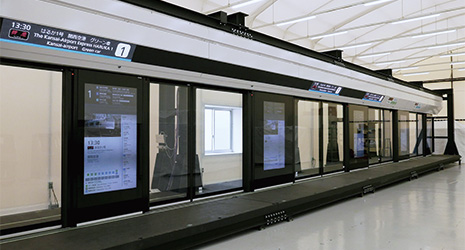February 2022
Train Station to Install Latest Type of Sliding Platform Screen Doors

Prototype of the new type of platform screen door -

The position of conventional platform screen doors is fixed.

Japanese train stations are increasingly installing platform screen doors to prevent passengers from falling onto the tracks or coming into contact with moving cars. We introduce a brand new sliding platform screen door with an opening that can be freely adjusted to accommodate any train type and number of cars, the first to be developed in the world.

In Fiscal Year 2019 in Japan, there were approximately 2,900 cases of people falling from station platforms and 160 cases of accidents involving people on platforms coming into contact with moving trains*. In order to prevent passengers from falling onto the tracks or coming into contact with moving cars, stations are increasingly installing platform screen doors. In the case of regular platform screen doors, when a train arrives at the platform, the sliding doors open and passengers get on and off the train. However, this method has severe limitations: the platform screen doors and car doors must be aligned in a fixed position and they cannot be used unless the position of all the car doors is the same.
In order to make the use of platform screen doors more widespread, these problems had to be solved. West Japan Railway Company, headquartered in Osaka, has developed the world’s first “full-screen” platform door that covers the entire platform edge from floor to ceiling, making it compatible with any type of train car. Installation of the new platform doors is planned for the Umekita (Osaka) Underground Station, scheduled to open in central Osaka in spring 2023.
“Many different kinds of trains will arrive at the new station in the future, and large numbers of passengers are expected to gather on the platforms. That’s why we set about developing a full-screen platform door that completely separates the track side from the platform side and ensures a high level of safety, and that has doors that can be moved freely to accommodate any train type and number of cars,” says Shikai Yuichi of the company’s Innovation Division, speaking alongside Kawai Yohei of the Facilities Division.
The new platform screen door is designed as a single block (equivalent to one car) consisting of five units: one wall-like “parent door” suspended from the top and two sets of glass “child doors.” The blocks are installed and connected to each other according to the length of the cars that stop at the station. The system works by automatically sliding each unit to match the length of the arriving train cars, then adjusting the parent and child doors to precisely align with the position of the car doors. In fact, when a train approaches the station, a special reader on the platform receives and reads the information on the ID tag installed on the train to identify the type of the train car. The type and number of cars of the incoming train are instantly identified, and the platform screen doors slide into the optimal position to align with its car doors.
The development process entailed a number of challenges. One was how to slim down the equipment.
“Compared to a conventional platform screen door, a wider variety of movements are possible with the new system and the internal structure for opening and closing the doors is more complex, increasing the overall thickness of the unit. This makes the width of the walkable platform space narrower, causing inconvenience to passengers moving along the platform. In order to solve this problem, we put the drive unit and wiring inside a box at the top of the door, making the door part slimmer,” says Shikai.
Another issue was how to make the doors operate more quickly. Door movement needs to be dynamic and precise in order to move the opening of the platform screen doors according to the type of train and number of cars. If the operating speed is slow, it will take longer for passengers to get on and off the train, and that might negatively affect the train schedule. In urban stations where trains arrive and depart every few minutes, a delay of several seconds can have a significant impact on the subsequent train schedule.
“We researched the optimal opening pattern according to the type of train and number of cars. We then developed an operating program in order to minimize how long and what distance the platform screen door slides. Not only that, but we also considered a system that would allow us to change the door layout according to the different stopping positions even for the same car type, thereby greatly reducing the opening and closing time,” says Kawai.
Once this new type of platform screen door has been successfully trialed at the Umekita (Osaka) Underground Station, it may also be introduced into other stations.
“In order to ensure that we provide our customers with a safer and more secure experience than possible with conventional platform doors, we have made use of new technologies and proceeded with development aiming for “the ultimate in safety assurance,” says Shikai. Kawai adds, “We’d like to continue technology development that focuses on the safety and security of our customers.”
* Source: Ministry of Land, Infrastructure, Transport and Tourism (https://www.mlit.go.jp/tetudo/content/001378759.pdf)



